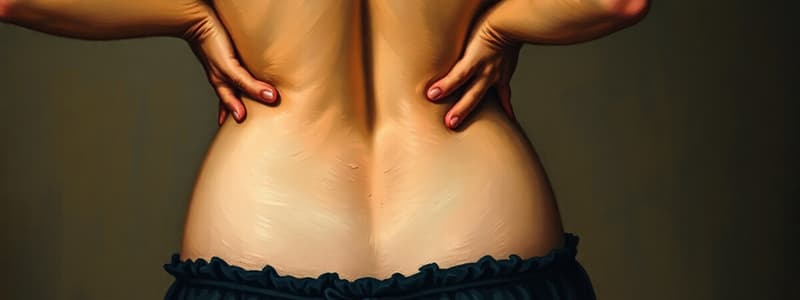Podcast
Questions and Answers
What is a common mechanical cause of low back pain during pregnancy?
What is a common mechanical cause of low back pain during pregnancy?
- Decreased bone density from pregnancy hormones
- Hyperextension of the spine due to hormonal changes
- Exaggerated lordosis due to an enlarging uterus (correct)
- Increased muscle strength from physical activity
Which of the following is a risk factor for Intrahepatic Cholestasis of Pregnancy (ICP)?
Which of the following is a risk factor for Intrahepatic Cholestasis of Pregnancy (ICP)?
- Single gestation pregnancies
- Prior history of ICP (correct)
- Severe nausea and vomiting
- High maternal body mass index
Which of the following statements is true regarding the management of low back pain in pregnancy?
Which of the following statements is true regarding the management of low back pain in pregnancy?
- Only physical therapy is effective
- Complete bed rest should be mandated
- Analgesics and behavioral modifications can be beneficial (correct)
- Surgical intervention is always required
What complication can arise from elevated bile acids in cases of Intrahepatic Cholestasis of Pregnancy?
What complication can arise from elevated bile acids in cases of Intrahepatic Cholestasis of Pregnancy?
Which symptom is commonly associated with Intrahepatic Cholestasis of Pregnancy (ICP)?
Which symptom is commonly associated with Intrahepatic Cholestasis of Pregnancy (ICP)?
Flashcards
Pregnancy-Related Low Back Pain
Pregnancy-Related Low Back Pain
Low back pain experienced during pregnancy, usually in the third trimester. It's caused by increased lordosis due to the growing uterus, weakened abdominal muscles, and relaxed ligaments.
Intrahepatic Cholestasis of Pregnancy (ICP)
Intrahepatic Cholestasis of Pregnancy (ICP)
A condition where the liver doesn't process bile properly during pregnancy, leading to a buildup of bile acids. Symptoms include itching, especially on hands and feet.
Elevated Bile Acids
Elevated Bile Acids
A major risk factor for Intrahepatic Cholestasis of Pregnancy (ICP), characterized by high levels of bile acids in the blood.
Fetal Complications in ICP
Fetal Complications in ICP
Signup and view all the flashcards
Ursodeoxycholic Acid
Ursodeoxycholic Acid
Signup and view all the flashcards
Study Notes
Low Back Pain in Pregnancy
- Common benign condition, often appearing in the third trimester.
- Characterized by radiating thigh pain, worsening with activity, and relieving with rest.
- Caused by exaggerated lordosis (curve in the lower back) from an enlarging uterus, weakened abdominal muscles, and joint/ligament laxity.
- Risk factors include previous pregnancies (multiparity), prior back pain, and significant weight gain.
- Crucial to rule out preterm labor or pyelonephritis (kidney infection).
- Reassurance and conservative management are typically sufficient, including behavioral modifications (supportive shoes, massage, firm mattress), and analgesics.
Intrahepatic Cholestasis of Pregnancy (ICP)
- Occurs during the third trimester due to increased estrogen and progesterone causing stasis in the liver's bile ducts and impairing bile flow.
- Leads to elevated bile acids in the liver and skin, resulting in itching (pruritus), especially on hands and feet.
- Elevated liver enzymes (aminotransferases) and bilirubin levels also occur.
- Risk factors include prior ICP, maternal age over 35, and multiple pregnancies.
- Bile acids can cross the placenta, posing fetal risks; the higher the maternal bile acid levels, the greater the fetal risk.
- Potential for Intrauterine Fetal Death (IUFD) exists.
- Management involves ursodeoxycholic acid (to lower bile acid levels), frequent monitoring of the mother and fetus, and delivery by 37 weeks.
Studying That Suits You
Use AI to generate personalized quizzes and flashcards to suit your learning preferences.




